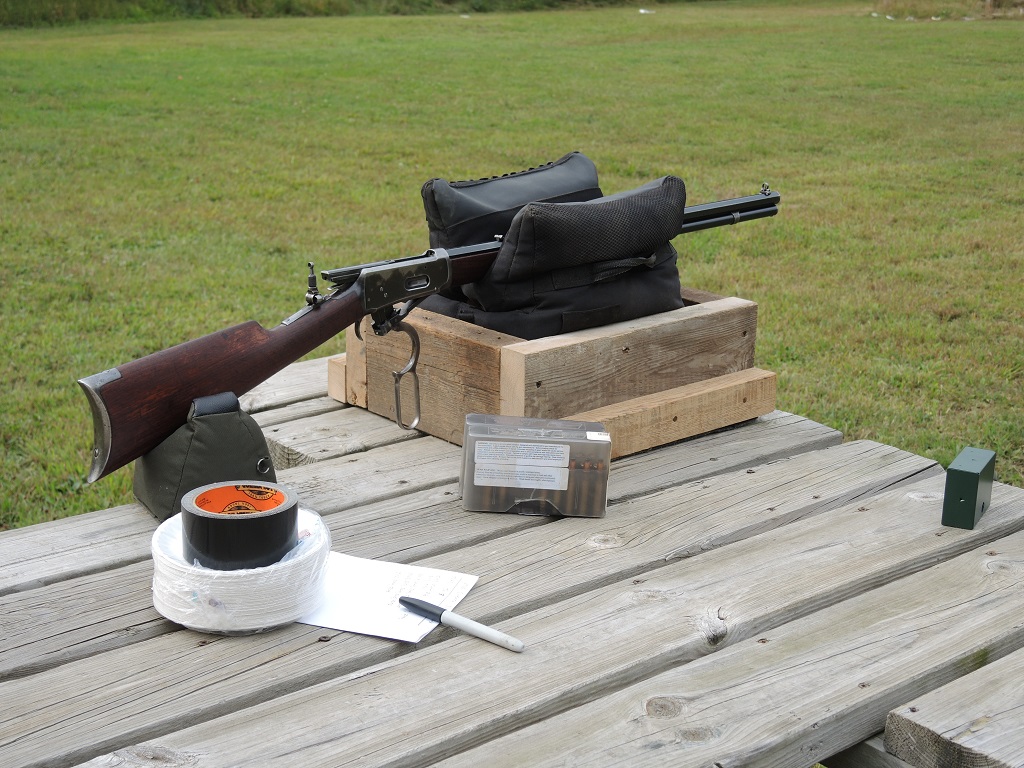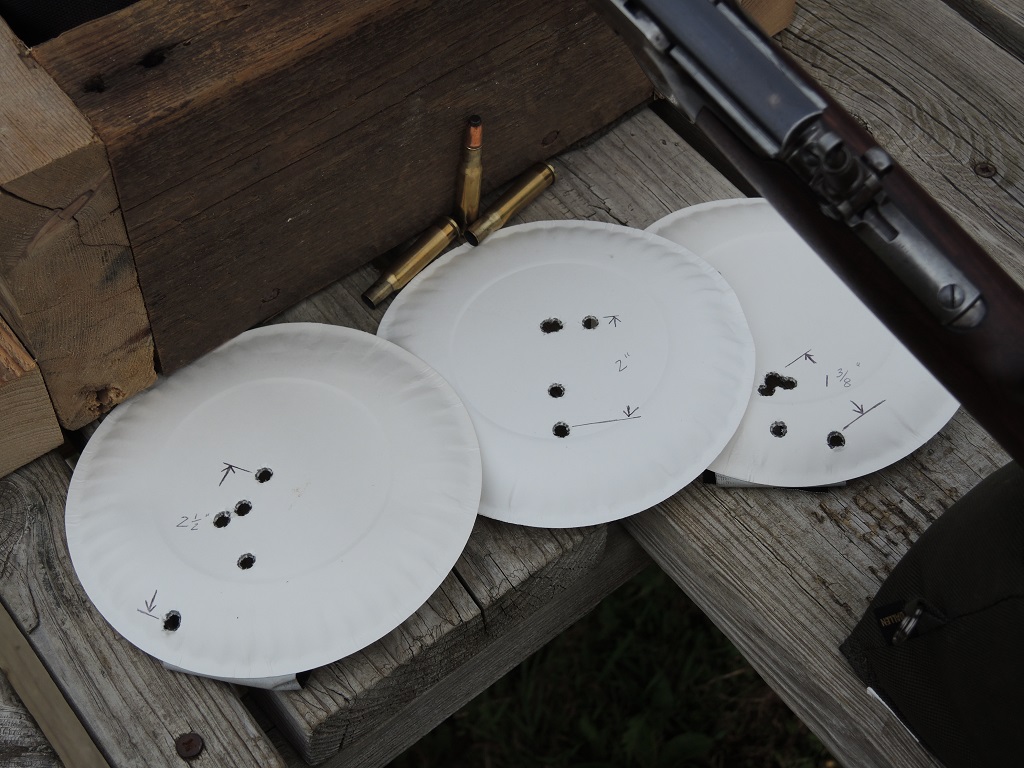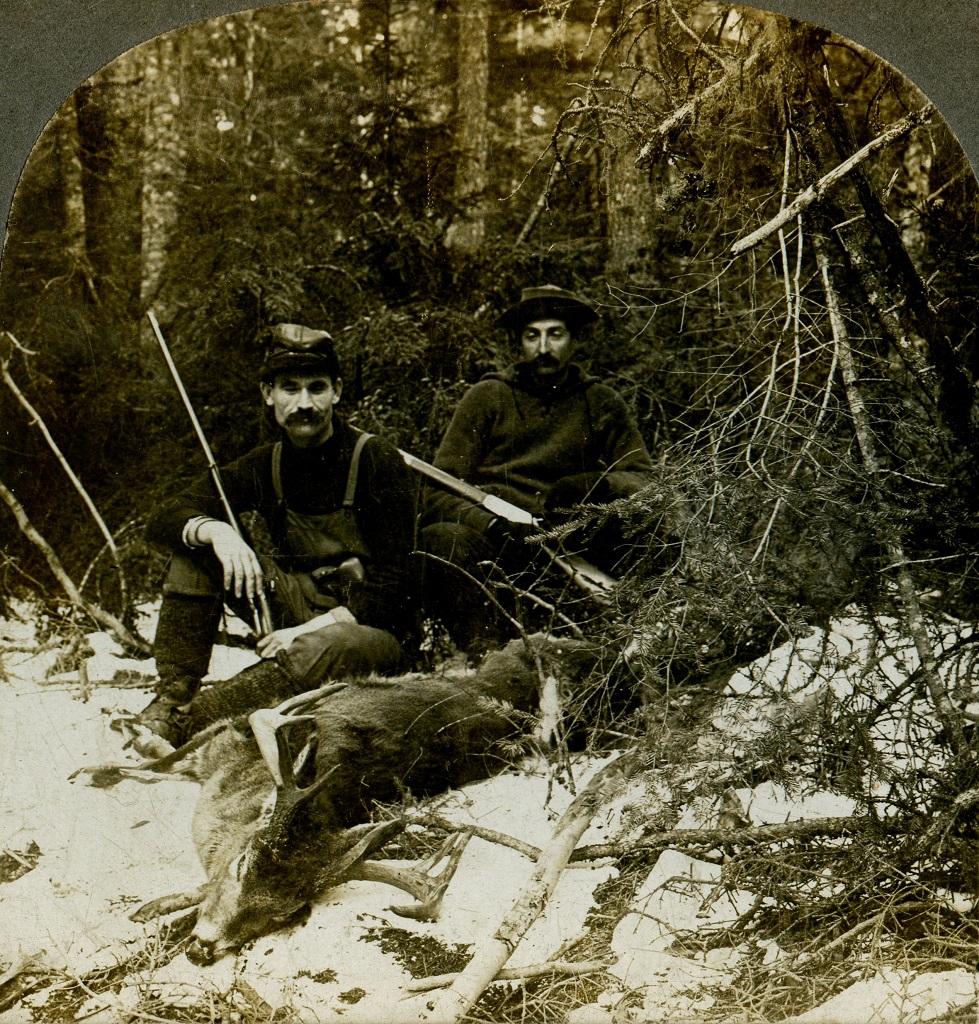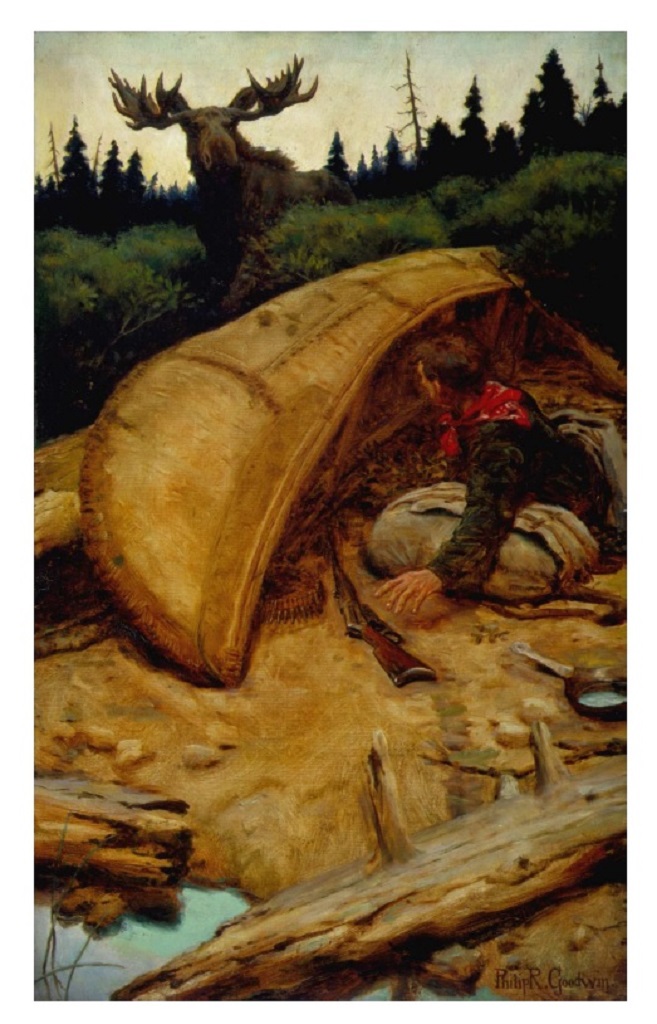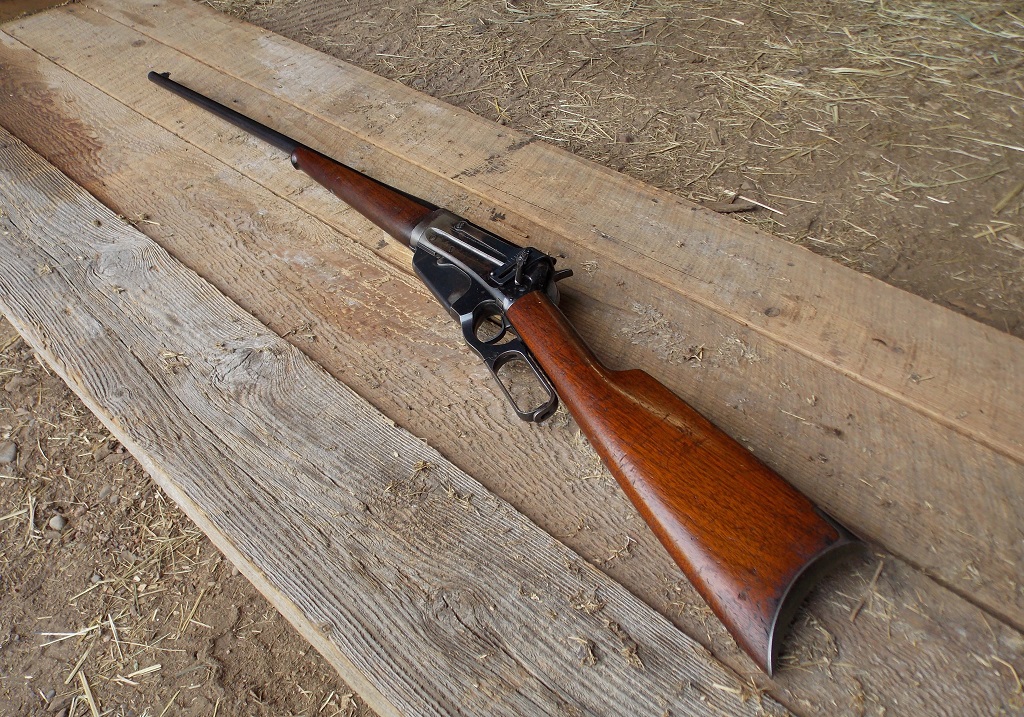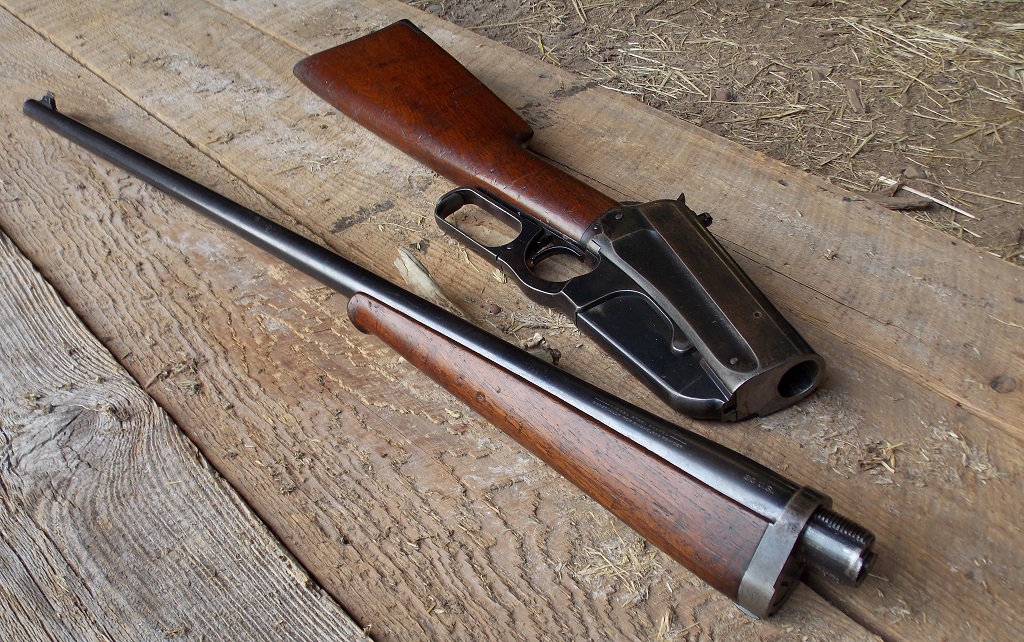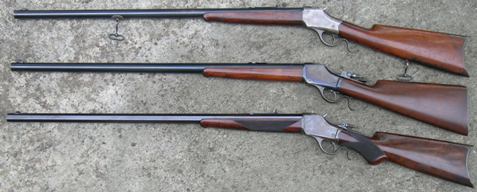I spent some time this last month with two Winchesters I plan on hunting with this fall. After shooting today I felt like I had enough to write a few things down. I’m a long way from being a great shooter from the bench or a great handloader, so getting input from you all is always a good learning experience. Generally if I find something seems to work well in either loading ammunition or firing the rifle I try to do it exactly the same every time in the hopes it will result in some consistency. Maybe some of you have some experiences to share, including chronograph use.
I read a lot from guys that did an awful lot of shooting and I’m always trying to read about what their accuracy expectations were for repeating lever action hunting rifles in the early smokeless calibers. My general goal with a lever action hunting rifle and aperture sights is to get consistent groups of around 2” at 100 yards. If I can do better…well that would be great. These would be groups shot at different times, usually five shots or lots of three shot groups and not just the one “internet group” shot one time that now suddenly gave me a minute of angle rifle.
One of the two rifles is my “go to” 1894 30WCF 26” octagon barreled rifle from 1907. It’s one of the first Winchesters I bought and it seems to shoot either 150 grain or 170 grain bullets well. I say it is my “go to” because it’s generally a consistent rifle for target shooting and this year I decided I would carry it in gun deer season for starters. It’s due. I also don’t really have a burning desire to carry a high condition original finish rifle through the brush for ten days with potential miserable conditions here in November. I like the trigger and the bore is very good. The fired brass doesn’t seem to stretch much either. I like to think a careful hunting old-timer used to carry it around every deer season and get his deer, clean the bore really well and then leave it alone until next deer season. Anyway that’s what I like to think…
For load development I started with both Speer and Sierra 170 grain bullets and I decided to stick with the 170 grain Sierra flat nose bullet and load it with IMR 4064. That bullet grouped better for me when testing otherwise identical loads and I have also had good results with that combination in another 30WCF 1894 rifle from the same time period. With this rifle I wanted to see what I’d get for accuracy around 2100fps+/-. This is what my chronograph recorded as average velocity of five shot groups with the 170 grain Sierra flat nose seated to a COL of 2.55” in Federal cases with Remington 9 ½ large rifle primers; the measurements taken at 15’ from the muzzle:
IMR 4064
29 grains 1922 fps
30 grains 1969 fps
31 grains 2020 fps
31.5 grains 2067 fps
I did take the measurements for 29-31 grains on an earlier day. Comparing these measurements to two older loading references I used for the 170 Sierra flat nose, I came up with the following: Sierra Second Edition, 29.9 grains IMR 4064-max load-2100fps. Pet Loads, 31 grains IMR 4064-2170fps-“good all-around load for lever actions”. The Hornady Third Edition manual shows a max load of 34 grains of IMR 4064 for their 170 grain bullet as another comparison. For whatever reason I recorded slightly lower velocities on average out of my rifle. In one instance I was a little over the max load and in another a little under. The fired cases look good. My set up is resulting in slightly lower measurements for some reason; I guess some combination of primer, powder bullet, rifle, chronograph and me having a hand in all of it. I’m content with where it’s at for now and can accept that the bullets might be traveling slightly faster than what I recorded. I don’t have another chronograph to compare with my chronograph but I will say that it seems to record tighter spreads in velocity with an extra shader (piece of cardboard taped on top of the shaders) in sunny conditions. Today it got windy at the shooting range when I got there and the cardboard started to act like a sail, so it had to be removed. It also clouded up. I realize I don’t have a top end chronograph here and my set ups probably aren’t perfect but I’m still getting some useful information. The chronograph is still something I’m learning how to use.
I’m usually comfortable with 6” paper plates on a brown background (insides of the boxes my last set of brake rotors came in). The plate is a small enough object out at 100 yards for my eyes using the 6 o’clock hold. I shot two rounds through the rifle to knock the dust off and then went to shooting my three, five-shot groups. The first group measured 2 ½”, second group 2” and final group 1 3/8”. My three groups with 31.5 grains showed extreme spreads of 23 fps, 31 fps and 39fps. I will point out the third group was fired using five cases from a different lot of Federal brass I have been using and the average velocity recorded was slightly lower for some reason than the other two. All fifteen cartridges were loaded during the same sitting with all other things being identical. You can see that the point of impact was slightly lower on the target also. It was one of my better five shot groups.
I noticed the vertical stringing improved with the last group also. Perhaps it was the different cases and maybe I was also more relaxed by the third group. I’m not sure but they averaged out to a little under 2” and that is what I was looking for. I would like to be at about 2-2 ½” above point of aim at 100 yards however. Other than that I’m about ready to go with this rifle.
Images of these Model 1895 rifles in action and an increasing interest in the early smokeless cartridges had me wanting a Model 1895 again, specifically a 28” barreled 30 US (30-40) rifle with a Lyman receiver sight. I looked at a few different ones but was happy to find this one from 1910 which has the Lyman sights front and rear but also had the feature of no rear barrel dovetail from the factory. I was not really looking for a takedown rifle but it was another added feature that took the rifle out of the norm.
I have heard a lot of great things about the 30-40 cartridge and these long barreled Model 1895s always looked like they should be pretty accurate. This rifle has a very good bore so I was excited. I wanted to replicate an early factory load with a 220 grain round nose bullet at about 1950-2050fps. It proved to be a little more difficult for me than I anticipated. It seemed to group very well for one group and then throw a flier that would give a group of 3-5” at 100 yards. This was frustrating for me and it caused be to reexamine a number of things.
The takedown joint itself is as tight as it can be and still function as a takedown. The rifle definitely feels tight. I guess the next step would be fusing it into a solid frame. Being a sight junkie I was really happy it had the early Lyman front blade but it was also the largest possible bead available, so I removed it and put on a later Marble Sheard blade with the smallest bead possible…at least for shooting purposes. I wondered about the forearm binding on the barrel somewhere so I tried relieving pressure and adding pressure; neither changed anything. I went to the eye doctor and got my prescription bumped up. Alongside loading for this rifle I was also loading and shooting the aforementioned 1894 rifle and a Model 70 30-’06 using the same methods and they shot as well as ever. I also loaded up some 180 grain Core-Lokts I had here just to try those. Nothing seemed to be preventing the seemingly random flier.
I talked to friends about shooting from the bench and got a few pointers I was grateful for, specifically making sure my technique was the same every time I fired a shot. I also read some more about bench shooting and decided I needed to change my rest. I started going to the public range. This was OK as I like the range except for the fact that you shoot from a picnic table. I have a heavy bag I like but I was always trying to get it at the right height and then it would gradually settle and I’d have to prop it up again. This goes back to the idea of doing everything the same way every time. So I built a heavy box for the bag with spacers underneath to adjust height. The sides keep the bag from settling down, which keeps it in the same place all the time. I nailed stiff carpet to the bottom surface. It doesn’t seem to move.
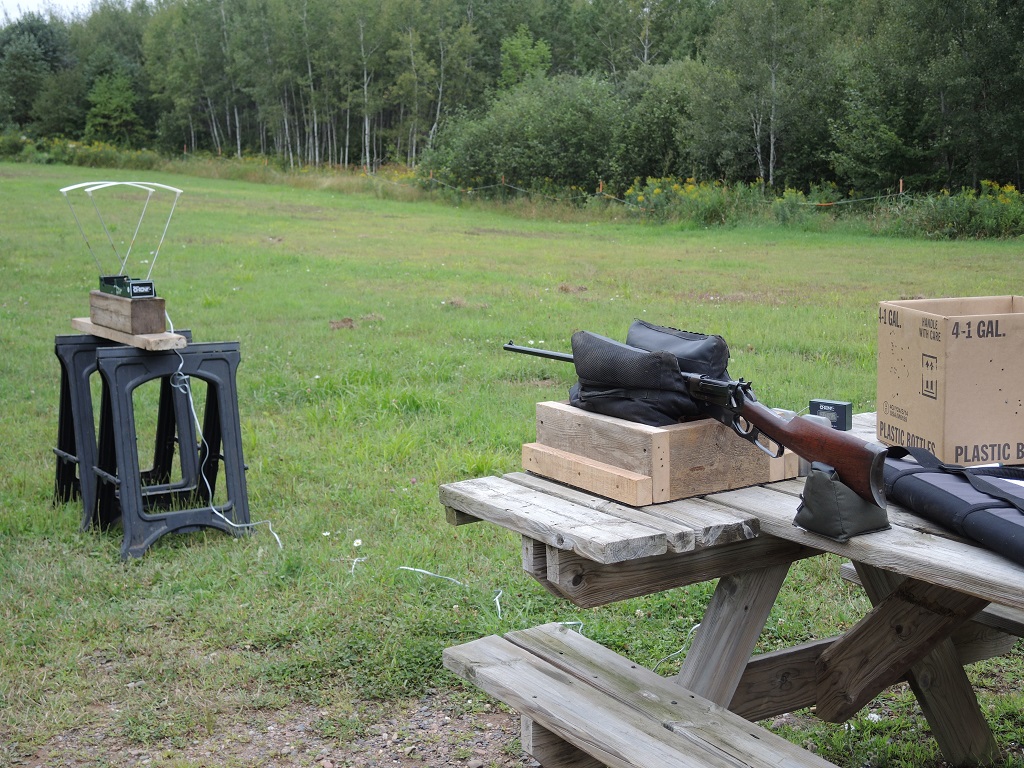

A few things I found with this rifle are that a 220 grain bullet out of a crescent butt has more recoil than I thought it would. I also found that the 28” barrel, referred to as a buggy whip barrel by my friend Dick, gets hot fast. For these reasons I became content with three shot groups. I also went back to shooting at 50 yard targets and doing a lot of chronograph work. I was using Sierra and Hornady 220 grain RN bullets, IMR 4350 and H4831 with WLR primers for my loads. For reference I used my Sierra and Hornady manuals and also Pet Loads. I found that around 41.5-42.5 grains of H4831 seemed to be the most accurate after shooting a lot of groups. Then I experimented with seating depth and found that the Hornady bullet seated to a COL of 3.085” started to do a little better for me. I combined all of these things and started to see better results.
Today I started with a few fouling shots and then three shot groups with 42.5 grains of H4831 and the Sierra 220 RN seated to a 3.089” COL. These averaged 2025fps with extreme spreads of 31fps. They grouped poorly; over 3” at 100 yards. The velocity numbers were not in the same zip code as what was listed in my Second Edition Sierra manual which shows 43.4 grains giving 1800fps as a starting load and 47.8 grains giving 2000fps as a max load out of a Krag rifle. Different rifles I guess.
Two following groups with 42.5 grains of H4831 and the Hornady 220 grain RN seated to a 3.085” COL averaged 2077fps. The exteme spread of six shots was 16 fps. They grouped very well. The first group measured 1 ¼”. It hit a little higher than I wanted so I lowered my rear sight before the next group, which measured 1 3/8”. This hit a little lower than I wanted but my groups were much improved regardless. This reflected what I was seeing the last time I shot at 50 yards as well. The average velocity I recorded on that day with 42.5 grains of H4831 and the 220 grain Hornady RN was lower at 2015fps but the extreme spread in velocity was only 15fps and at 50 yards made a cloverleaf on the target. My chronograph set up between the two days could not be exactly the same and I believe the average velocity difference is partially the result of that. The Third Edition Hornady manual lists 42.5 grains of H4831 at 2000fps with their bullet seated to 3.080” out of a 30” barreled Springfield Model 1898. I imagine the true velocity of my load is somewhere around 2015-2077fps.
There are a few bullet options for the 30-40 cartridge that I have yet to try. I imagine one or more of them could be accurate too. I wanted to start with something close to the original 220 grain load. It took awhile but I got there. I would call this particular rifle somewhat unforgiving I guess. Between loading the ammunition and shooting it seemed like I have to do everything perfect to avoid fliers. It did force me to examine what I had been doing and make a few changes that should result in better shooting in the future. Takedown rifle accuracy is sort of a hot button topic here sometimes. I’m not really sold either way on the subject yet after loading and shooting some of each type intensively the last several years. Now that I have what I think are accurate hunting loads for me with both rifles I will likely be doing target shooting with lesser loads and maybe cast bullets with these rifle in the future.
So, there is a handful about two rifles I’ve been using a lot lately. Winchester ran the “What a .30 Caliber Winchester Cartridge Will Do” ad in their catalogs back in the 1890s. These are the cartridges they were referring to and hopefully this fall and winter I will have some opportunities to find out exactly what they will do.
Brad
GREAT write-up! Thanks for posting the information. I have a couple of 1895’s in .30 US but have never shot them due to lack of decent ammo. Your testing has inspired me to do some loading of my own and get them to the range. Neither of mine are a take-down model, yours looks neat and should make a great hunting rifle. Thanks again for taking the time to share your experience.
Regards,
WACA Life Member #6284 - Specializing in Pre-64 Winchester .22 Rimfire
Glad you fellows enjoyed the post and hopefully made it all the way through.
I should have said that “there are many bullet options for the 30-40 cartridge yet for me to try”. In Townsend Whelen’s The American Rifle he had a lot of good things to say about that cartridge and listed a lot of loads with powders that were faster burners than IMR 4350 or H4831. It would be interesting to try some alongside the powders I’m already using for a bullet around 180 grains or so. So many rifles to handload for!
I also would add that I wouldn’t be surprised if I yanked the trigger once and awhile or developed a flinch with the rifle after the first few times I took it to the range. Hopefully I’m getting it right now.
Brad
Brad
I have only shot factory Winchester and Dominion in my 1895 first model 30-40 , and was surprised at the power of the factory loads. It is quite accurate with the issued standard sights , but the thin barrel heats up fast. Not a concern for hunting. I wont load for this as I have too many cals to load for now, but always like to read the loading and shooting reports
Love your Jack O’conner ‘glass half full’ quote
Phil

Phil
He was a great writer and slipped in the humor once and awhile.
A flatside like yours would be a neat rifle. I’ve always been interested in the Model 1895 Rifles and am happy to have one again. I wasn’t planning on hunting with it at first because a lot of times it’s lots of brush here and I thought it would be awkward. It’s starting to grow on me however. A friend suggested sitting with it if I was to do so, so I think it will be cutting up to the front of the line ahead of some other rifles for that opportunity.
Brad
Hey Bruce, glad you enjoyed it. Have you shot that nice antique 30WCF you posted about a year or so ago?
Brad
Brad
I test fired that old beauty and now it is a safe queen. Busy summer with a young family ,but the leaves are starting to change colour now so I well have to figure out witch one I well take to the deer woods this fall. I have a couple nice 38-55’s that I enjoy shooting and hunting with that are less then 100,000 serial number range if I get time all post some pics.
Thanks for good post Brad take care and good luck with this falls hunt.
Bruce
Aim Small ,Miss Small
I have continued practicing with this 30WCF 1894 rifle. One of the other members here asked me if I had read an article about bench shooting lever guns in the Nov. issue of Rifle by Brian Pearce, so I did and thought I would try some of those methods I had not tried before.
I’m still using my aforementioned load of 31.5 grains of IMR 4064 and the Sierra 170 flat nose bullet. I am crimping all of them now however. I also have put a well used WF Sheard 30/30 gold bead front sight on the rifle that I found this summer. I think it will be better in the brush and I like the small “gold” bead type sights for hunting.
I have some loose factory rounds around here from partial boxes given to me so I’m shooting those to warm up and also to recover some once fired brass for future use. I typically have let the forearm rest loose on the front bag and held my left hand on the rear bag under the butt of the rifle to adjust elevation when I shoot this rifle. Once and awhile if things aren’t looking good with other rifles I will hold the forearm with my left hand instead to see if anything different shows up on the target. Today to start I went with holding the forearm with my left hand in front of the bag very snug and also with the rifle butt below my shoulder and into it very snug. I did however leave a rear bag under the butt, but with minimal contact. I usually rest my right elbow on my empty gun case to where it is comfortable. I also put the targets out at only 50 yards today in the event my vision is an issue. Here is the target I brought home (I use the same piece of cardboard over and over and that’s why there is a marked off hole at the upper left). I fired a fouling shot, or warm up shot or whatever you want to call it with one of the factory rounds I mentioned earlier. I proceeded to fire three, walk down and look and repeated that twice more.
It was only 50 yards as mentioned, but the rifle and load seems to do very well yet. The two three shot groups on the bottom are about 1″ above my POA with the 6 o’clock hold. Again I have one particular lot of Federal brass, the same cases that I used in the earlier post above, that impacts higher on the target than the other Federal cases I’m using. I keep them separated and for what ever reason they must be responsible for slightly higher velocity as all other things are equal and these cartridges are being reloaded in the same sitting. Could this be caused by different case capacity and resulting higher pressure?
I next tried some things from the Rifle article out on one other target using the method described of holding the forearm and then resting my hand and forearm on the bag; and then also not using a rear bag at all. I didn’t get beyond a few shots because I could not hold quite steady enough like this compared to what I had been doing and I thought I was going to be wasting ammo. I will have to try it again, starting with a .22 rifle to get used to it. My initial thoughts are it might be something that I could get comfortable with after some continued practice. I didn’t bring that target back for a picture…
This article got me thinking about trying different methods of sighting in rifles than I had used before. I was wondering what some of you all do and what has worked for you. I’d be interested in hearing what someone else does. I will also mention that with my 33WCF 1886 I hold the forearm rather than leaving it rest loose on the bag. It definitely seems to have tighter groups in elevation that way. I’m left with thinking there are a few methods that can have good results and the particular method is what is most comfortable at the time with that particular rifle.
Brad
Great write-up Brad.
I read an article in the September 2015 American Rifleman Magazine titled “Mastering The Lightest of Rifles” and they make a few points that have helped me–Ive developed lots of bad habits over the years. I had grown accustomed to shooting off of a lead sled–it helped with the recoil but it did not allow me to get in behind the rifle/carbine and get a good feel/contact. Ive moved on to bags or blankets for the front and back when target shooting. The article also mentions, that pressure on the forearm (pulling straight down) will help improve accuracy because it keeps the rifle/carbine from jumping when the shot is fired–it reduces the effects of the recoil until the bullet leaves the muzzle. I noticed that my groups improved when using this little tip–Im used to leave my left hand resting on the bench. It also mentioned keeping only light contact between the cheek and stock so that pressure between the two is consistent for all shots. While the article was about lightweight bolt action rifles it may have some applications here.
Shooting sometimes reminds me of golf, you can easily set yourself up to fail. The harder you try, the faster you tend to take your next shot hoping to do better and when that doesnt work you rush through them that much faster only to find you suck because you dont have the discipline and patience to make the right shot. 
1892takedown @sbcglobal.net ......NRA Endowment Life Member.....WACA Member
"God is great.....beer is good.....and people are crazy"... Billy Currington
Thanks for sharing your experiences from the bench Chris. I seem to be very careful about holding the same and putting the same pressure on with my cheek. I do catch myself not paying attention to my breathing all of the time and not applying the same trigger pull every single time. I think I notice this more because I’m paying close attention to calling the shot. Sort of what you are saying about discipline. The best groups seem to come from doing everything correctly, sometimes feeling effortless to do so and I suppose that comes with practice, training and the discipline.
Brad
Wow! You fellows put quite a bit of finesse into your target shooting. Your methods seem sound. More universally accepted than are mine.
My preferred rest–from a side-sliding window: open the window about 24″, set a 36″ stuffed animal (House Bunny) on the sill, pull the window snugly against his big tummy, lay your Winchester fore-stock in your hand and across his head or shoulder (depends on the chair height), pull the rifle butt against your shoulder, smash or fluff up House Bunny’s head to find the proper elevation. The remainder is easy–squeeze off the shot, and smile. Many of my load tests are with the aid of House Bunny; he holds very still. And, he too has a smile on his face when the shooting is done.
1 Guest(s)


 Log In
Log In Members
Members Home
Home

 Add Reply
Add Reply Add Topic
Add Topic Offline
Offline



